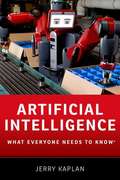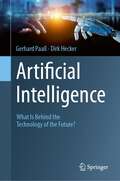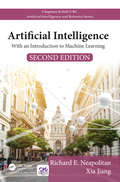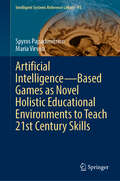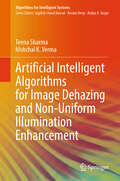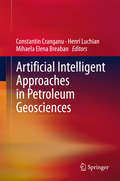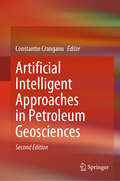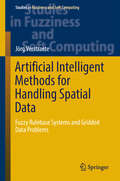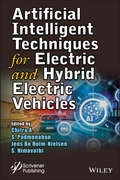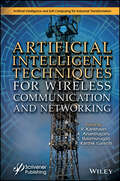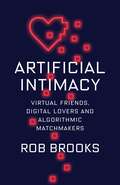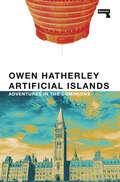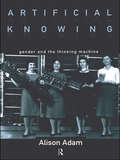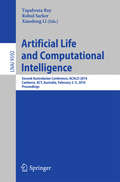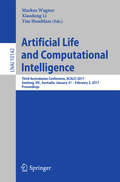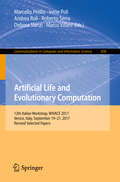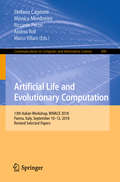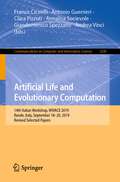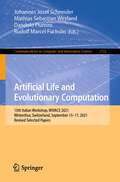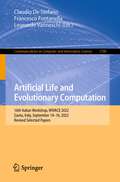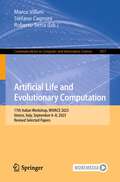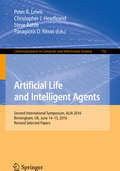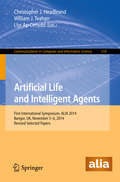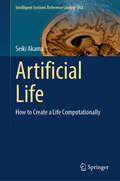- Table View
- List View
Artificial Intelligence: What Everyone Needs to Know
by Jerry KaplanOver the coming decades, Artificial Intelligence will profoundly impact the way we live, work, wage war, play, seek a mate, educate our young, and care for our elderly. It is likely to greatly increase our aggregate wealth, but it will also upend our labor markets, reshuffle our social order, and strain our private and public institutions. Eventually it may alter how we see our place in the universe, as machines pursue goals independent of their creators and outperform us in domains previously believed to be the sole dominion of humans. Whether we regard them as conscious or unwitting, revere them as a new form of life or dismiss them as mere clever appliances, is beside the point. They are likely to play an increasingly critical and intimate role in many aspects of our lives. The emergence of systems capable of independent reasoning and action raises serious questions about just whose interests they are permitted to serve, and what limits our society should place on their creation and use. Deep ethical questions that have bedeviled philosophers for ages will suddenly arrive on the steps of our courthouses. Can a machine be held accountable for its actions? Should intelligent systems enjoy independent rights and responsibilities, or are they simple property? Who should be held responsible when a self-driving car kills a pedestrian? Can your personal robot hold your place in line, or be compelled to testify against you? If it turns out to be possible to upload your mind into a machine, is that still you? The answers may surprise you.
Artificial Intelligence: What Is Behind the Technology of the Future?
by Gerhard Paaß Dirk HeckerArtificial Intelligence (AI) is already present in our daily routines, and in the future, we will encounter it in almost every aspect of life – from analyzing X-rays for medical diagnosis, driving autonomous cars, maintaining complex machinery, to drafting essays on environmental problems and drawing imaginative pictures. The potentials of AI are enormous, while at the same time many myths, uncertainties and challenges circulate that need to be tackled. The English translation of the book “Künstliche Intelligenz – Was steckt hinter der Technologie der Zukunft?” originally published in German (Springer Vieweg, 2020), this book is addressed to the general public, from interested citizens to corporate executives who want to develop a better and deeper understanding of AI technologies and assess their consequences. Mathematical basics, terminology, and methods are explained in understandable language. Adaptations to different media such as images, text, and speech and the corresponding generative models are introduced. A concluding discussion of opportunities and challenges helps readers evaluate new developments, demystify them, and assess their relevance for the future.
Artificial Intelligence: With an Introduction to Machine Learning (Second Edition) (Chapman & Hall/CRC Artificial Intelligence and Robotics Series)
by Richard E. Neapolitan Xia JiangThe first edition of this popular textbook, Contemporary Artificial Intelligence, provided an accessible and student friendly introduction to AI. This fully revised and expanded update, Artificial Intelligence: With an Introduction to Machine Learning, Second Edition, retains the same accessibility and problem-solving approach, while providing new material and methods. The book is divided into five sections that focus on the most useful techniques that have emerged from AI. The first section of the book covers logic-based methods, while the second section focuses on probability-based methods. Emergent intelligence is featured in the third section and explores evolutionary computation and methods based on swarm intelligence. The newest section comes next and provides a detailed overview of neural networks and deep learning. The final section of the book focuses on natural language understanding. Suitable for undergraduate and beginning graduate students, this class-tested textbook provides students and other readers with key AI methods and algorithms for solving challenging problems involving systems that behave intelligently in specialized domains such as medical and software diagnostics, financial decision making, speech and text recognition, genetic analysis, and more.
Artificial Intelligence—Based Games as Novel Holistic Educational Environments to Teach 21st Century Skills (Intelligent Systems Reference Library #93)
by Maria Virvou Spyros PapadimitriouThis book offers a visionary look at how AI can promote learning for modern skillsets by examining the fusion of AI, prosocial gaming, personalisation, ethics, and education. The book introduces the EPATHLO Suite, a novel AI platform that personalises both educational content and gameplay, creating tailor-made learning experiences and entertainment for each student. By blending personalised games with education, these AI-driven environments make learning more dynamic and enjoyable, while focusing on prosocial behaviour development, encouraging cooperation, empathy, and ethical understanding. It also provides roles for human teachers, as content creators of the EPATHLO Suite authoring tool. The book highlights the importance of twenty-first-century skills—such as critical thinking, collaboration, communication, and creativity—while also addressing ethical issues like data privacy (including GDPR compliance). It provides practical AI-driven solutions and reviews relevant literature, offering a comprehensive understanding of these interconnected fields. This book is an indispensable resource for those looking to explore these state-of-the-art topics. It is ideal for academics, researchers, students, educators, game designers, programmers, and professionals in the educational gaming industry who want to understand AI's role in shaping the future of education with games. Whether readers aim to enhance their classroom, develop new learning technologies, or better grasp the evolving technology of educational games with AI, this book offers valuable knowledge and practical tools for success.
Artificial Intelligent Algorithms for Image Dehazing and Non-Uniform Illumination Enhancement (Algorithms for Intelligent Systems)
by Nishchal K. Verma Teena SharmaThis book offers a detailed insight of artificial intelligence (AI) algorithms for image dehazing and non-uniform illumination enhancement. In this book, various image enhancement techniques under hazy and non-uniform illumination conditions are discussed. The book specifically provides a detail on how to approach image enhancement under different outdoor conditions using AI tools. The biggest benefit a reader would accrue is to get exposed to the various aspects one should take care of while working with digital images. The book also includes multiple inventions which were recently introduced by the authors for image enhancement and reviews the state of the art in respective subject matters.
Artificial Intelligent Approaches in Petroleum Geosciences
by Constantin Cranganu Henri Luchian Mihaela Elena BreabanThis book presents several intelligent approaches for tackling and solving challenging practical problems facing those in the petroleum geosciences and petroleum industry. Written by experienced academics, this book offers state-of-the-art working examples and provides the reader with exposure to the latest developments in the field of intelligent methods applied to oil and gas research, exploration and production. It also analyzes the strengths and weaknesses of each method presented using benchmarking, whilst also emphasizing essential parameters such as robustness, accuracy, speed of convergence, computer time, overlearning and the role of normalization. The intelligent approaches presented include artificial neural networks, fuzzy logic, active learning method, genetic algorithms and support vector machines, amongst others. Integration, handling data of immense size and uncertainty, and dealing with risk management are among crucial issues in petroleum geosciences. The problems we have to solve in this domain are becoming too complex to rely on a single discipline for effective solutions and the costs associated with poor predictions (e. g. dry holes) increase. Therefore, there is a need to establish a new approach aimed at proper integration of disciplines (such as petroleum engineering, geology, geophysics and geochemistry), data fusion, risk reduction and uncertainty management. These intelligent techniques can be used for uncertainty analysis, risk assessment, data fusion and mining, data analysis and interpretation, and knowledge discovery, from diverse data such as 3-D seismic, geological data, well logging, and production data. This book is intended for petroleum scientists, data miners, data scientists and professionals and post-graduate students involved in petroleum industry.
Artificial Intelligent Approaches in Petroleum Geosciences
by Constantin CranganuThis book presents cutting-edge approaches to solving practical problems faced by professionals in the petroleum industry and geosciences. With various state-of-the-art working examples from experienced academics, the book offers an exposure to the latest developments in intelligent methods for oil and gas research, exploration, and production. This second edition is updated with new chapters on machine learning approaches, data-driven modelling techniques, and neural networks. The book delves into machine learning approaches, including evolutionary algorithms, swarm intelligence, fuzzy logic, deep artificial neural networks, KNN, decision tree, random forest, XGBoost, and LightGBM. it also analyzes the strengths and weaknesses of each method and emphasizes essential parameters like robustness, accuracy, speed of convergence, computer time, overlearning, and normalization. Integration, data handling, risk management, and uncertainty management are all crucial issues in petroleum geosciences. The complexities of these problems require a multidisciplinary approach that fuses petroleum engineering, geology, geophysics, and geochemistry. Essentially, this book presents an approach for integrating various disciplines such as data fusion, risk reduction, and uncertainty management. Whether you are a professional or a student, you can greatly benefit from the latest advancements in intelligent methods applied to oil and gas research. This comprehensive and updated book presents cutting-edge approaches and real-world examples that can help you in solving the intricate challenges of the petroleum industry and geosciences.
Artificial Intelligent Methods for Handling Spatial Data: Fuzzy Rulebase Systems and Gridded Data Problems (Studies in Fuzziness and Soft Computing #370)
by Jörg VerstraeteThis book provides readers with an insight into the development of a novel method for regridding gridded spatial data, an operation required to perform the map overlay operation and apply map algebra when processing spatial data. It introduces the necessary concepts from spatial data processing and fuzzy rulebase systems and describes the issues experienced when using current regridding algorithms. The main focus of the book is on describing the different modifications needed to make the problem compatible with fuzzy rulebases. It offers a number of examples of out-of-the box thinking to handle aspects such as rulebase construction, defuzzification, spatial data comparison, etc. At first, the emphasis is put on the newly developed method, and additional datasets containing information on the underlying spatial distribution of the data are identified. After this, an artificial intelligent system (in the form of a fuzzy inference system) is constructed using this knowledge and then applied on the input data to perform the regridding. The book offers an example of how an apparently simple problem can pose many different challenges, even when trying to solve it with existing soft computing technologies. The workflow and solutions to solve these challenges are universal and may therefore be broadly applied into other contexts.
Artificial Intelligent Techniques for Electric and Hybrid Electric Vehicles
by S. Himavathi Chitra A. P. Sanjeevikumar, Jens Bo Holm-NielsenElectric vehicles/hybrid electric vehicles (EV/HEV) commercialization is still a challenge in industries in terms of performance and cost. The performance along with cost reduction are two tradeoffs which need to be researched to arrive at an optimal solution. This book focuses on the convergence of various technologies involved in EV/HEV. The book brings together the research that is being carried out in the field of EV/HEV whose leading role is by optimization techniques with artificial intelligence (AI). Other featured research includes green drive schemes which involve the possible renewable energy sources integration to develop eco-friendly green vehicles, as well as Internet of Things (IoT)-based techniques for EV/HEVs. Electric vehicle research involves multi-disciplinary expertise from electrical, electronics, mechanical engineering and computer science. Consequently, this book serves as a point of convergence wherein all these domains are addressed and merged and will serve as a potential resource for industrialists and researchers working in the domain of electric vehicles.
Artificial Intelligent Techniques for Wireless Communication and Networking
by S. Balamurugan R. Kanthavel K. Ananthajothi R. Karthik GaneshARTIFICIAL INTELLIGENT TECHNIQUES FOR WIRELESS COMMUNICATION AND NETWORKING The 20 chapters address AI principles and techniques used in wireless communication and networking and outline their benefit, function, and future role in the field. Wireless communication and networking based on AI concepts and techniques are explored in this book, specifically focusing on the current research in the field by highlighting empirical results along with theoretical concepts. The possibility of applying AI mechanisms towards security aspects in the communication domain is elaborated; also explored is the application side of integrated technologies that enhance AI-based innovations, insights, intelligent predictions, cost optimization, inventory management, identification processes, classification mechanisms, cooperative spectrum sensing techniques, ad-hoc network architecture, and protocol and simulation-based environments. Audience Researchers, industry IT engineers, and graduate students working on and implementing AI-based wireless sensor networks, 5G, IoT, deep learning, reinforcement learning, and robotics in WSN, and related technologies.
Artificial Intimacy: Virtual Friends, Digital Lovers, and Algorithmic Matchmakers
by Rob BrooksWhat happens when the human brain, which evolved over eons, collides with twenty-first-century technology? Machines can now push psychological buttons, stimulating and sometimes exploiting the ways people make friends, gossip with neighbors, and grow intimate with lovers. Sex robots present the humanoid face of this technological revolution—yet although it is easy to gawk at their uncanniness, more familiar technologies based in artificial intelligence and virtual reality are insinuating themselves into human interactions. Digital lovers, virtual friends, and algorithmic matchmakers help us manage our feelings in a world of cognitive overload. Will these machines, fueled by masses of user data and powered by algorithms that learn all the time, transform the quality of human life?Artificial Intimacy offers an innovative perspective on the possibilities of the present and near future. The evolutionary biologist Rob Brooks explores the latest research on intimacy and desire to consider the interaction of new technologies and fundamental human behaviors. He details how existing artificial intelligences can already learn and exploit human social needs—and are getting better at what they do. Brooks combines an understanding of core human traits from evolutionary biology with analysis of how cultural, economic, and technological contexts shape the ways people express them. Beyond the technology, he asks what the implications of artificial intimacy will be for how we understand ourselves.
Artificial Islands: Adventures in the Dominions
by Owen HatherleyShould Britain form a new union with its old 'Dominions' in Canada, Australia and New Zealand? Are they really our closest allies and relations? And is there any reason why they should want to unite again with us?Great Britain has just left one Union, after years of bitter argument and divisive posturing. But what if the island's future lies in another Union altogether, with some of its former colonial &“kith and kin&” across the seas? Why be in a Union with your immediate neighbours, when you could instead be in a trans-oceanic super-state with our old friends in Canada, Australia and New Zealand? Welcome to the strange world of the 'CANZUK Union', the name for a quixotic but apparently serious plan to reunify the white-majority 'Dominions' of the British Empire under the flag of low taxes, strong borders and climate change denialism.Artificial Islands tests the idea that Britain's natural allies and closest relations are in these three countries in North America and the Antipodes, through a good look at the histories, townscapes and spaces of several cities across the settler zones of the British Empire. These are some of the most purely artificial and modern landscapes in the world, British-designed cities that were built with extreme rapidity in forcibly seized territories on the other side of the world from Britain. Were these places really no more than just a reproduction of British Values planted in unlikely corners of the globe? How are people in Auckland, Melbourne, Montreal, Ottawa and Wellington re-imagining their own history, or their countries' role in the British Empire and their complicity in its crimes? And do they have any interest in a union with us?
Artificial Knowing: Gender and the Thinking Machine
by Alison AdamArtificial Knowing challenges the masculine slant in the Artificial Intelligence (AI) view of the world. Alison Adam admirably fills the large gap in science and technology studies by showing us that gender bias is inscribed in AI-based computer systems. Her treatment of feminist epistemology, focusing on the ideas of the knowing subject, the nature of knowledge, rationality and language, are bound to make a significant and powerful contribution to AI studies. Drawing from theories by Donna Haraway and Sherry Turkle, and using tools of feminist epistemology, Adam provides a sustained critique of AI which interestingly re-enforces many of the traditional criticisms of the AI project. Artificial Knowing is an esential read for those interested in gender studies, science and technology studies, and philosophical debates in AI.
Artificial Life After Frankenstein
by Eileen M. HuntArtificial Life After Frankenstein brings the insights born of Mary Shelley's legacy to bear upon the ethics and politics of making artificial life and intelligence in the twenty-first century.What are the obligations of humanity to the artificial creatures we make? And what are the corresponding rights of those creatures, whether they are learning machines or genetically modified organisms? In seeking ways to respond to these questions, so vital for our age of genetic engineering and artificial intelligence, we would do well to turn to the capacious mind and imaginative genius of Mary Wollstonecraft Shelley (1797-1851). Shelley's novels Frankenstein; or, The Modern Prometheus (1818) and The Last Man (1826) precipitated a modern political strain of science fiction concerned with the ethical dilemmas that arise when we make artificial life—and make life artificial—through science, technology, and other forms of cultural change.In Artificial Life After Frankenstein, Eileen Hunt Botting puts Shelley and several classics of modern political science fiction into dialogue with contemporary political science and philosophy, in order to challenge some of the apocalyptic fears at the fore of twenty-first-century political thought on AI and genetic engineering. Focusing on the prevailing myths that artificial forms of life will end the world, destroy nature, and extinguish love, Botting shows how Shelley modeled ways to break down and transform the meanings of apocalypse, nature, and love in the face of widespread and deep-seated fear about the power of technology and artifice to undermine the possibility of humanity, community, and life itself.Through their explorations of these themes, Mary Shelley and authors of modern political science fiction from H. G. Wells to Nnedi Okorafor have paved the way for a techno-political philosophy of living with the artifice of humanity in all of its complexity. In Artificial Life After Frankenstein, Botting brings the insights born of Shelley's legacy to bear upon the ethics and politics of making artificial life and intelligence in the twenty-first century.
Artificial Life and Computational Intelligence: Second Australasian Conference, ACALCI 2016, Canberra, ACT, Australia, February 2-5, 2016, Proceedings (Lecture Notes in Computer Science #9592)
by Tapabrata Ray Ruhul Sarker Xiaodong LiThis bookconstitutes the proceedings of the Second Australasian Conference on ArtificialLife and Computational Intelligence, ACALCI 2016, held in Canberra, ACT,Australia, in February 2016. The 30 fullpapers presented in this volume were carefully reviewed and selected from 41submissions. They are organized in topical sections named: mathematicalmodeling and theory; learning and optimization; planning and scheduling;feature selection; and applications and games.
Artificial Life and Computational Intelligence: Third Australasian Conference, ACALCI 2017, Geelong, VIC, Australia, January 31 – February 2, 2017, Proceedings (Lecture Notes in Computer Science #10142)
by Xiaodong Li Markus Wagner Tim HendtlassThis book constitutes the refereed proceedings of the Third Australasian Conference on Artificial Life and Computational Intelligence, ACALCI 2017, held in Geelong, VIC, Australia, in January/February 2017. The 32 papers presented in this volume were carefully reviewed and selected from 47 submissions. They were organized in topical sections named: artificial life and computational intelligence and optimization algorithms and applications.
Artificial Life and Evolutionary Computation: 12th Italian Workshop, WIVACE 2017, Venice, Italy, September 19-21, 2017, Revised Selected Papers (Communications In Computer And Information Science #830)
by Irene Poli Marcello Pelillo Marco Villani Roberto Serra Andrea Roli Debora SlanziThis book constitutes the revised selected papers of the 12th Italian Workshop on Advances in Artificial Life, Evolutionary Computation, WIVACE 2017, held in Venice, Italy, in September 2017.The 23 full papers presented were thoroughly reviewed and selected from 33 submissions. They cover the following topics: physical-chemical phenomena; biological systems; economy and society; complexity; optimization.
Artificial Life and Evolutionary Computation: 13th Italian Workshop, WIVACE 2018, Parma, Italy, September 10–12, 2018, Revised Selected Papers (Communications in Computer and Information Science #900)
by Stefano Cagnoni Marco Villani Andrea Roli Monica Mordonini Riccardo PecoriThis book constitutes the revised selected papers of the 13th Italian Workshop on Artificial Life and Evolutionary Computation, WIVACE 2018, held in Parma, Italy, in September 2018. The 12 full papers presented were thoroughly reviewed and selected from 30 submissions. They cover the following topics: Boolean networks and complex systems; economic, societal and technological applications; chemical, biological and medical applications. The chapter “Unveiling Latent Relations in the Photonics Techno-Economic Complex System” is open access under a CC BY 4.0 license at link.springer.com.
Artificial Life and Evolutionary Computation: 14th Italian Workshop, WIVACE 2019, Rende, Italy, September 18–20, 2019, Revised Selected Papers (Communications in Computer and Information Science #1200)
by Antonio Guerrieri Clara Pizzuti Giandomenico Spezzano Franco Cicirelli Andrea Vinci Annalisa SocievoleThis book constitutes the revised selected papers of the 14th Italian Workshop on Artificial Life and Evolutionary Computation, WIVACE 2019, held in Rende, Italy, in September 2019.The 13 full papers and 4 short paper presented were thoroughly reviewed and selected from 31 submissions. They are focused on the topics of information systems, design and analysis of algorithms, artificial intelligence, machine learning, cognitive science, modeling and simulation, collaborative and social computing, parallel computing, distributed computing. The chapter “Nestedness Temperature in the Agent-Artifact Space: Emergence of Hierarchical Order in the 2000-2014 Photonics Techno-Economic Complex System” is available open access under a CC BY 4.0 license.
Artificial Life and Evolutionary Computation: 15th Italian Workshop, WIVACE 2021, Winterthur, Switzerland, September 15–17, 2021, Revised Selected Papers (Communications in Computer and Information Science #1722)
by Johannes Josef Schneider Mathias Sebastian Weyland Dandolo Flumini Rudolf Marcel FüchslinThis book constitutes the proceedings of the 15th Italian Workshop on Artificial Life and Evolutionary Computation, WIVACE 2021, held in Winterthur, Switzerland, in September 2022. The 14 full papers and 10 short papers presented in this volume were carefully reviewed and selected from 25 submissions. The papers are organized in the following topical sections: Networks; Droplets, Fluids, and Synthetic Biology; Robot Systems; Computer Vision and Computational Creativity; Semantic Search; Artificial Medicine and Pharmacy; Trade and Finance; Ethics in Computational Modelling.
Artificial Life and Evolutionary Computation: 16th Italian Workshop, WIVACE 2022, Gaeta, Italy, September 14–16, 2022, Revised Selected Papers (Communications in Computer and Information Science #1780)
by Leonardo Vanneschi Claudio De Stefano Francesco FontanellaThis book constitutes the refereed proceedings of the 16th Italian Workshop on Artificial Life and Evolutionary Computation, WIVACE 2022, held in Gaeta, Italy, during September 14–16, 2022. The 21 full papers and 3 short papers included in this book were carefully reviewed and selected from 45 submissions. They were organized in topical sections as follows: answer set programming; networks and complex systems, metaheuristics, robotics, and machine learning
Artificial Life and Evolutionary Computation: 17th Italian Workshop, WIVACE 2023, Venice, Italy, September 6–8, 2023, Revised Selected Papers (Communications in Computer and Information Science #1977)
by Stefano Cagnoni Marco Villani Roberto SerraThis book constitutes the refereed post proceedings of the 17th Italian Workshop on Artificial Life and Evolutionary Computation, WIVACE 2023, held in Venice, Italy, during September 6–8, 2023.The 30 full papers included in this book were carefully reviewed and selected from 55 submissions. They were organized in topical sections as follows: Algorithms for complex systems, Biologically inspired models, Complex chemical systems, Adaptation and swarms, Learning, Medicine and Social systems.
Artificial Life and Intelligent Agents: First International Symposium, ALIA 2014, Bangor, UK, November 5-6, 2014. Revised Selected Papers (Communications In Computer And Information Science #732)
by Christopher J. Headleand Peter R. Lewis Panagiotis D. Ritsos Steve BattleThis book constitutes the refereed proceedings of the Second International Symposium on Artificial Life and Intelligent Agents, ALIA 2016, held in Birmingham, UK, in June 2016. The 8 revised full papers and three revised short papers presented together with two demo papers were carefully reviewed and selected from 25 submissions. The papers are organized in topical sections on modelling; robotics; bio-inspired problem solving; human-like systems; applications and games.
Artificial Life and Intelligent Agents: First International Symposium, ALIA 2014, Bangor, UK, November 5-6, 2014. Revised Selected Papers (Communications in Computer and Information Science #519)
by Christopher J. Headleand William J. Teahan Llyr Ap CenyddThis book constitutes the refereed proceedings of the First International Symposium on Artificial Life and Intelligent Agents, ALIA 2014, held in Bangor, UK, in November 2014. The 10 revised full papers were carefully reviewed and selected from 20 submissions. The papers are organized in topical sections on learning and evolution; human interaction; robotic simulation.
Artificial Life: How to Create a Life Computationally (Intelligent Systems Reference Library #262)
by Seiki AkamaThis book provides some resources of Artificial Life. Artificial Life (ALife or A-Life) is the research area which simulates a life computationally. It involves several approaches to living systems in artificial manners. It was recognized as a scientific field in the 1980's. Artificial Life is related to many scientific fields including biology and computer science, and its history is old. In fact, the earlier works have been done by people like Turing and von Neumann. Fields like that neural networks, evolutionary computation, and cellular automaton constitute the foundations for Artificial Life. The so-called wet ware is an approach in more biology-oriented, which is known that there are some Artificial Life Systems at present. It is expected to see further progresses of this exciting field. The materials include: history, philosophy, related areas, recent developments, etc. Starting from the overview, the authors give an exposition of basic subjects like cellular automaton, neural networks, evolutionary computation, and wet ware. The authors also introduce some examples of Artificial Life Systems like Boids, Tierra, and Open Warm. The book is intended for those, like experts and students, who wish to get involved in the field as a monograph or a textbook for the subject. It is also useful for beginners. But, the authors assume that the reader has mastered the material ordinarily covered in AI and mathematics.
